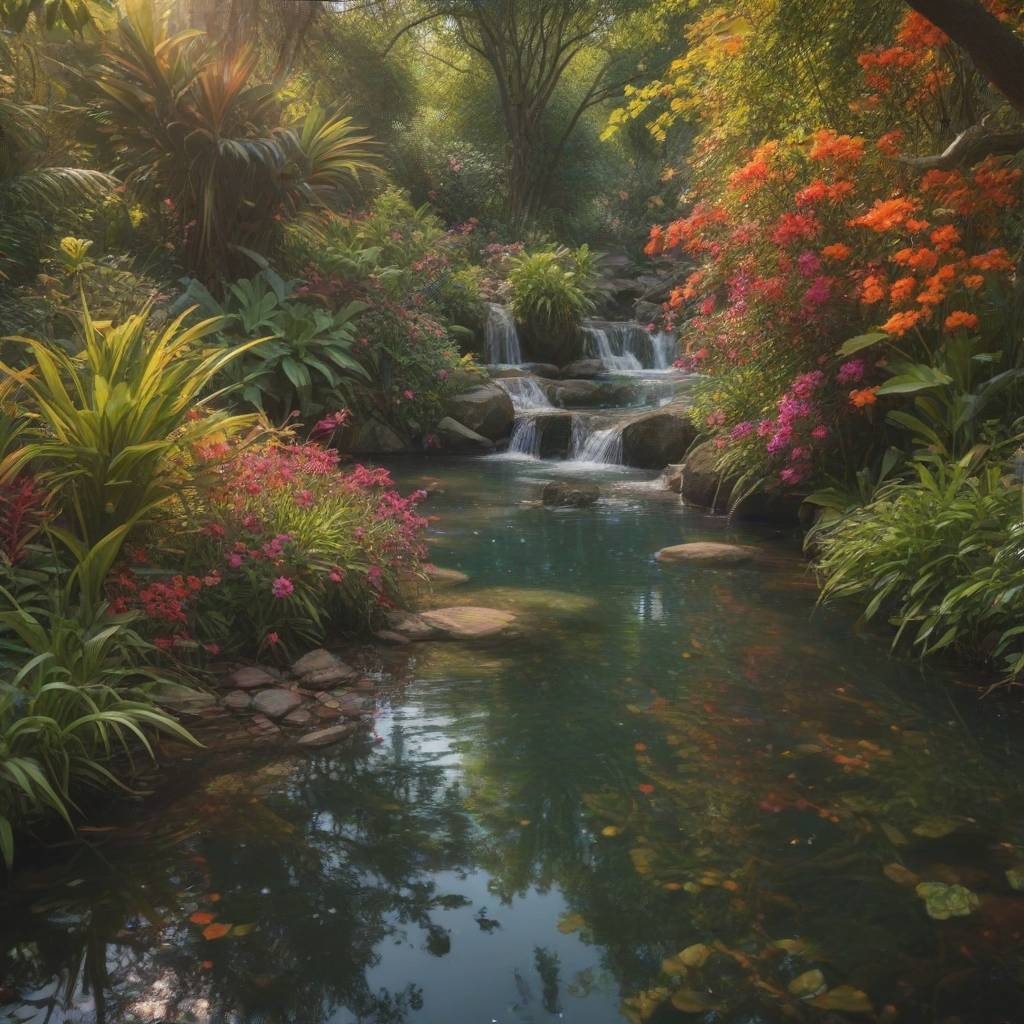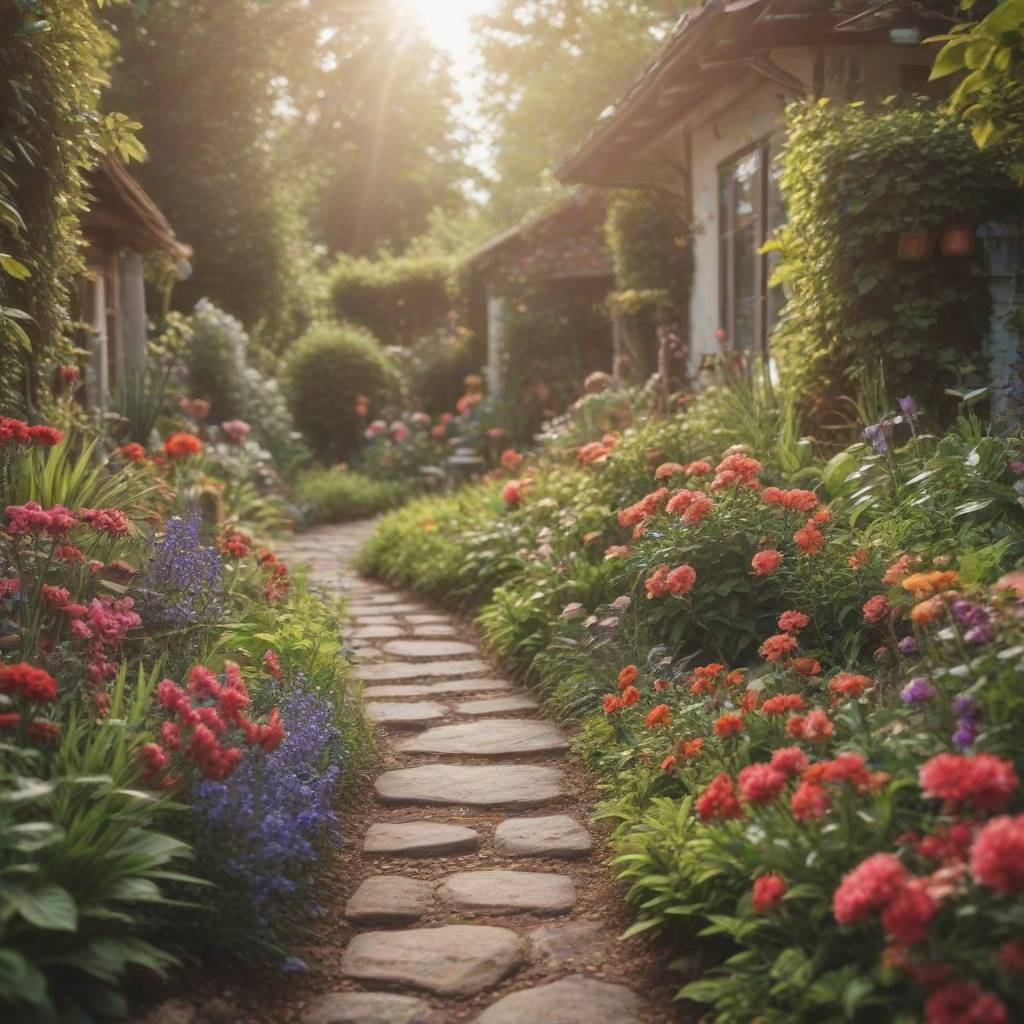A theme garden is a carefully planned and designed outdoor space that follows a specific theme or concept. Unlike traditional gardens, which may have a mix of various plants and elements, theme gardens focus on a singular idea or aesthetic throughout the entire garden.
The theme can be inspired by various sources such as cultural traditions, historical periods, geographical regions, or abstract concepts. It often incorporate specific plants, colors, textures, and architectural features that are relevant to the chosen theme. The goal is to create a cohesive and immersive experience for visitors, transporting them to a different place, time, or mood when ever they visit to explore the garden. Here are a few popular theme garden ideas:
Explore Planters For your garden- https://zardens.com/enquiry/
Enchanted “Forest Garden“
Let’s design an enchanting theme garden called the “Enchanted Forest Garden.” This garden will transport visitors to a magical realm filled with whimsy, mystery, and natural beauty.
Design Concept:
The Enchanted Forest Garden will be a lush, immersive experience that combines elements of fantasy with the wonders of nature. The garden will be divided into several sections, each representing a different aspect of the enchanted forest theme.
Entrance:
Visitors will enter through an arched gateway adorned with intricate metalwork resembling twisting vines and delicate fairy wings. As they step inside, they’ll be greeted by a canopy of towering trees that arch overhead, creating a sense of entering a mystical realm.
Pathways:
Meandering pathways will wind through the garden, bordered by wildflowers, ferns, and moss-covered rocks. Soft lighting hidden among the foliage will create a magical glow, guiding visitors deeper into the forest.
Focal Points:
Throughout the garden, hidden clearings and glades will feature enchanting focal points:
Fairy Circle: A circular clearing surrounded by toadstools and moss-covered stones, where visitors can imagine fairies dancing under the moonlight.
Glowing Pond: A tranquil pond illuminated by softly glowing lights, where water lilies and aquatic plants thrive. Visitors can rest on rustic benches and listen to the soothing sound of trickling water.
Giant’s Chair: A colossal wooden chair nestled beneath a towering oak tree, inviting visitors to climb and imagine themselves as giants in the forest.
Secret Garden: A secluded corner hidden behind a curtain of vines, where a hidden door leads to a magical garden filled with rare and exotic plants.
Plant Selection: The plant selection will include a mix of native and exotic species chosen for their enchanting qualities:
Magical Trees: Majestic oak, beech, and willow trees will dominate the canopy, with twisted branches reaching towards the sky.
Fairy Flowers: Delicate blooms in shades of lavender, blue, and pink will attract butterflies and hummingbirds, including foxgloves, bluebells, and columbines.
Mystical Shrubs: Shrubs with colorful foliage, such as purple smoke bush and variegated hydrangeas, will add depth and texture to the undergrowth.
Whimsical Ground Cover: Low-growing plants like creeping thyme, ferns, and mosses will carpet the forest floor, creating a lush, verdant carpet.
Importance Look-Wise:
The Enchanted Forest Garden will captivate visitors with its otherworldly beauty and immersive atmosphere. From the moment they step through the gate, they’ll feel transported to a magical realm where every corner holds a new discovery. The lush greenery, vibrant flowers, and whimsical touches will create a visually stunning landscape that inspires wonder and delight.
Importance Nature-Wise:
Nature-wise, the Enchanted Forest Garden will serve as a sanctuary for native wildlife, providing habitat and food sources for birds, butterflies, and other beneficial insects. By incorporating native plants and sustainable gardening practices, the garden will promote biodiversity and support the local ecosystem. Visitors will have the opportunity to connect with nature on a deeper level, fostering appreciation and stewardship for the natural world.
Overall, the Enchanted Forest Garden will be a magical oasis where imagination thrives, and the beauty of nature reigns supreme. It will offer visitors a tranquil escape from the hustle and bustle of everyday life, inviting them to explore, dream, and rediscover the enchantment of the natural world.
Herbal “Herb Garden“
Creating an herb garden theme can be an enchanting endeavor, blending functionality with beauty and a touch of aromatic delight. Here’s how to design an irresistibly attractive herb garden:
Layout and Design:
Layout: Begin with a well-defined layout, such as raised beds, geometric patterns, or circular designs, to add visual interest, Incorporate pathways or stepping stones to guide visitors through the garden and provide access for harvesting. Consider adding decorative elements like trellises, arbors, or herb spirals for vertical interest.
Plant Selection: Choose a diverse array of herbs with different colors, textures, and growth habits to create visual appeal, Group herbs with similar cultural requirements together to optimize growing conditions and make maintenance easier.Incorporate edible flowers and ornamental herbs like lavender and rosemary to add interest and fragrance.
Color Palette:Aim for a harmonious color scheme that complements the surrounding landscape or your preferred aesthetic.Mix vibrant greens with pops of color from flowering herbs like basil, chamomile, and calendula.Intersperse silver-gray foliage herbs like sage and thyme to add contrast and visual intrigue.
Seasonal Interest:
Plan for year-round appeal by selecting herbs that offer seasonal interest through foliage, flowers, or berries.Include early blooming herbs like chives and cilantro in spring, followed by summer favorites such as basil and mint.Extend the garden’s beauty into fall with herbs like sage and rosemary, which offer attractive foliage and often bloom late into the season.
Container Gardens and Accessories:
Incorporate containers of varying sizes, shapes, and materials to add depth and dimension to the garden.Personalize the space with herb-themed accessories such as decorative plant markers, vintage gardening tools, and whimsical sculptures.Consider including a seating area or cozy nook where visitors can relax and savor the sights and scents of the garden.
Importance Nature Wise:
Herb gardens attract beneficial insects like bees, butterflies, and predatory insects, contributing to a healthy ecosystem.
Many herbs, such as basil and dill, repel pests, reducing the need for chemical pesticides and promoting natural pest control.
Herbs like lavender and mint emit fragrances that deter mosquitoes and other nuisance insects, making the garden a more enjoyable place to spend time.
An herb garden theme not only enhances the visual appeal of your outdoor space but also provides countless opportunities for culinary exploration, aromatic indulgence, and ecological enrichment. With careful planning and attention to detail, your herb garden can become a captivating oasis that delights the senses and nourishes the soul.
Japanese “Zen Garden“
Creating a Japanese Zen Garden theme is a beautiful endeavor, marrying simplicity, tranquility, and symbolic meaning. Imagine stepping into a serene oasis where every element invites you to find inner peace and harmony with nature.
Design ideas
Raked Gravel or Sand: The centerpiece of a Zen garden, meticulously raked gravel or sand represents water, evoking a sense of calm and fluidity. The patterns created by raking can symbolize waves, ripples, or even the flow of energy.
Rocks and Stones:Strategically placed rocks and stones serve as focal points, representing islands or mountains emerging from the “sea” of gravel. They embody strength, stability, and the passage of time, adding a sense of permanence to the garden.
Minimalist Plantings: In a Zen garden, plantings are intentionally kept simple and sparse, with an emphasis on form, texture, and seasonal interest. Evergreen shrubs like Japanese maple, bamboo, and pine are common choices, along with mosses and ferns for ground cover.
Bridges and Pathways: Wooden bridges or stepping stones lead visitors through the garden, encouraging contemplation and mindfulness as they traverse the space. Pathways may be gravel, stone, or moss-covered, inviting gentle exploration.
Water Features: While traditional Zen gardens often eschew standing water, a small, simple water feature like a bamboo fountain or a stone basin can add an element of sound and movement, enhancing the garden’s sensory experience.
Lanterns and Ornaments: Lanterns, pagodas, and other traditional Japanese ornaments add visual interest and cultural authenticity to the garden. They may be strategically placed to cast soft light and shadows, especially in the evening.
Importance Look-wise:
A Japanese Zen Garden is visually captivating for several reasons:
Simplicity: Its minimalist design creates a sense of spaciousness and serenity, allowing visitors to focus on the beauty of each individual element.
Balance and Harmony: Every aspect of the garden is carefully considered and arranged to achieve a harmonious balance between natural and man-made elements.
Texture and Contrast: The juxtaposition of smooth gravel, rough stones, and delicate foliage creates a visually stimulating tapestry of textures and contrasts.
Seasonal Variation: Through careful selection of plants and materials, a Zen garden offers ever-changing scenery, with each season bringing its own colors, textures, and sensations.
Promotes Mindfulness: The deliberate design of a Zen garden encourages visitors to slow down, observe, and appreciate the present moment, fostering a deeper connection with nature and oneself.
Creates Habitat: Even though minimalist, a Zen garden can still support biodiversity by providing habitat for small creatures like insects and birds, especially if native plants are incorporated.
Sustainable Design:
With its emphasis on simplicity and natural materials, a Zen garden often embodies principles of sustainability, requiring minimal water and maintenance once established.
Emotional Well-being: Interacting with a Zen garden can have profound psychological benefits, reducing stress, promoting relaxation, and encouraging a sense of tranquility and inner peace.
In essence, a Japanese Zen Garden theme is not just about creating a visually stunning space; it’s about fostering a deeper connection with nature, promoting mindfulness, and nurturing the soul. Its allure lies not only in its aesthetic appeal but also in its ability to inspire contemplation and renewal.
Timeless “Mediterranean Garden“
A Mediterranean Garden is a captivating oasis inspired by the sun-drenched landscapes of Southern Europe. Its importance lies in its ability to transport you to a realm of timeless beauty, where the senses are indulged and the spirit is rejuvenated. Let’s delve into the allure of a Mediterranean Garden, both in its aesthetic appeal and its ecological significance:
Aesthetic Appeal:
Warm Color Palette: Picture a palette of warm, earthy tones—sandy yellows, terracotta oranges, and deep Mediterranean blues. These colors evoke the sunlit shores and rustic villages of the Mediterranean coast.
Textured Surfaces: From weathered terracotta pots to rough-hewn stone pathways, textures abound in a Mediterranean Garden. These elements add depth and interest, inviting you to touch and explore.
Lush Greenery: Mediterranean gardens showcase an abundance of foliage, ranging from silvery olive trees to aromatic lavender bushes. The contrast between vibrant greens and dusty hues creates a visually dynamic landscape.
Fragrant Blooms: Imagine the intoxicating scents of jasmine, rosemary, and citrus blossoms wafting through the air. Fragrant flowers such as bougainvillea, oleander, and geraniums add bursts of color and perfume to the garden.
Artful Arrangements: Whether it’s a cluster of terra cotta pots overflowing with herbs or a vine-covered pergola casting dappled shade, Mediterranean gardens are masterpieces of composition. Every element is thoughtfully placed to create a harmonious whole.
Importance Nature Wise:
Drought Resistance: One of the key features of Mediterranean gardens is their emphasis on drought-tolerant plants. Species like lavender, sage, and thyme thrive in the hot, dry conditions characteristic of the Mediterranean climate, making them ideal choices for water-wise gardening.
Biodiversity: Despite the arid climate, Mediterranean gardens are teeming with life. Native plants attract a variety of pollinators, from bees and butterflies to hummingbirds and songbirds. By cultivating a diverse array of flora, you create a thriving ecosystem that supports local wildlife.
Soil Health: Mediterranean plants are well-adapted to the nutrient-poor, well-draining soils of their native habitat. Their deep root systems help prevent soil erosion and improve soil structure, enhancing the overall health of the garden ecosystem.
Low Maintenance: Once established, Mediterranean gardens require minimal maintenance, making them an eco-friendly choice for the busy gardener. By choosing plants that are well-suited to the local climate and soil conditions, you can create a sustainable garden that thrives with minimal intervention.
By embracing the beauty and resilience of Mediterranean flora, you can create a garden that not only captivates the eye but also nurtures the soul and supports local biodiversity. Whether you’re seeking a peaceful retreat or a vibrant gathering space, a Mediterranean Garden offers endless possibilities for enchantment and inspiration.
Rainy “Rain Garden“
Creating a Rain Garden theme offers an opportunity to blend beauty with environmental stewardship, resulting in a visually stunning and ecologically beneficial space. Here’s a description of a Rain Garden theme and its allure:
Design Concept:
Picture a serene oasis where lush greenery mingles with vibrant bursts of color, punctuated by the gentle melody of trickling water. The Rain Garden theme seamlessly integrates elements of nature-inspired design with sustainable landscaping practices.
Visual Appeal:
Color Palette: Embrace a harmonious blend of hues reminiscent of a natural landscape. Imagine a palette dominated by verdant greens, accented with pops of jewel-toned flowers and foliage in shades of blue, purple, and yellow, evoking the diverse beauty of native flora.
Texture and Form: Play with a variety of textures and forms to create visual interest. Combine delicate ferns and grasses with bold, architectural plants like irises and ornamental grasses. Intersperse clusters of low-growing groundcovers for a carpet-like effect, contrasting with the verticality of taller specimens.
Water Feature: The focal point of the Rain Garden, a meandering stream or bubbling fountain, adds a dynamic element to the landscape. Incorporate natural stone accents and strategically placed boulders to mimic the rugged beauty of a mountain stream.
Seasonal Interest: Ensure year-round appeal by selecting plants that offer seasonal interest. Spring brings the delicate blooms of native wildflowers like purple coneflower and butterfly weed, while the fiery foliage of ornamental grasses steals the show in autumn.
Environmental Benefits:
Stormwater Management: Rain Gardens act as natural sponges, absorbing and filtering stormwater runoff from rooftops, driveways, and other impermeable surfaces. This helps reduce the risk of flooding and prevents pollutants from entering local waterways.
Habitat Creation: By providing a habitat for native plants and wildlife, Rain Gardens contribute to biodiversity conservation. Native pollinators like butterflies and bees are attracted to the nectar-rich blooms, while birds and beneficial insects find refuge among the foliage.
Soil Health: The deep-rooted plants in a Rain Garden help improve soil structure and prevent erosion. Their extensive root systems also enhance infiltration, allowing water to percolate into the ground and recharge groundwater supplies.
Sustainable Landscaping:
Rain Gardens require minimal maintenance once established, reducing the need for irrigation, fertilizers, and pesticides. Their self-sustaining nature makes them an eco-friendly landscaping option for homeowners and communities alike.
A Rain Garden theme offers not only visual appeal but also tangible benefits for the environment. By transforming stormwater management into a work of art, this theme celebrates the beauty of nature while promoting ecological resilience and sustainability.
It’s an invitation to immerse oneself in the tranquility of a garden that not only looks breathtaking but also serves as a sanctuary for wildlife and a model for responsible land stewardship.
Charming “Cottage Garden“
A Cottage Garden is like a painting brought to life, bursting with color, fragrance, and an enchanting sense of nostalgia. It’s a whimsical blend of flowers, herbs, and sometimes vegetables, arranged in a seemingly haphazard yet meticulously planned manner. Here’s how to create a Cottage Garden that is not only visually stunning but also beneficial for nature:
Abundant Planting :
Cottage Gardens are all about lushness and abundance. Fill your garden beds with a mix of perennials, biennials, and self-seeding annuals to create layers of color and texture. Think of tall spires of delphiniums and foxgloves towering over cascades of roses and lavender, punctuated by the cheerful faces of daisies and cosmos.
Color Palette: Embrace a riot of colors in your Cottage Garden, but aim for a harmonious color scheme that ties everything together. Consider a mix of pastels and vibrant hues, with pops of contrasting colors to add interest. You might choose soft pinks, blues, and whites for a romantic feel, or opt for bold reds, oranges, and yellows for a more vibrant look.
Informal Design: Unlike formal gardens with rigid structure, Cottage Gardens exude a charming informality. Plant in drifts and clusters rather than straight lines, and allow plants to spill over pathways and borders for a relaxed, lived-in feel. Incorporate rustic elements like weathered wooden fences, trellises, and stone pathways to enhance the cottage-like atmosphere.
Seasonal Interest:
Ensure year-round beauty by selecting plants with staggered blooming times and foliage that provides interest even when flowers are not in bloom. Include early spring bulbs like daffodils and tulips, summer-flowering favorites like roses and coneflowers, and fall-blooming asters and sedums to keep the garden vibrant throughout the seasons.
Wildlife Habitat: Cottage Gardens are not just for humans—they also provide valuable habitat and food sources for pollinators and other wildlife. Choose nectar-rich flowers like bee balm, coneflowers, and butterfly bush to attract bees, butterflies, and hummingbirds. Incorporate native plants to support local ecosystems, and include a water feature like a birdbath or small pond to invite birds and beneficial insects.
Fragrance: Engage the senses with the intoxicating scents of Cottage Garden blooms. Include fragrant plants like roses, lavender, sweet peas, and jasmine to perfume the air and create an inviting atmosphere for both humans and pollinators.
Personal Touches:
Infuse your Cottage Garden with personal touches that reflect your personality and interests. Incorporate vintage garden ornaments, heirloom plants passed down through generations, or whimsical decorations like fairy houses and colorful birdhouses to add charm and character.
creating a Cottage Garden theme is visually captivating and ecologically beneficial and you will have a beautiful outdoor space to not only enjoy but also contribute to the health and vitality of your Garden, local envirnment and society.
Zardens Planters-https://zardens.com/enquiry/ to match Every Indivisual Requirment.visit Website for more Details.













